Trace Amounts of Co3O4 Nano-Particles Modified TiO2 Nanorod Arrays for Boosted Photoelectrocatalytic Removal of Organic Pollutants in Water
Abstract
1. Introduction
2. Experimental
2.1. Preparation of TiO2 Nanorod Arrays
2.2. Fabrication of Ultra Small Co3O4 Coated TiO2 Nanorod Arrays
2.3. Photo-Electrochemical Studies of the Co3O4 Modified TiO2 Nanorod Arrays
2.4. The Photo-Electrochemical Degradation Research
3. Results and Discussions
3.1. XRD Analysis
3.2. Scanning Electron Microscopy (SEM) and Transmission Electron Microscopy (TEM) Measurement
3.3. X-ray Photoelectron Spectroscopy (XPS) Analysis
3.4. Photocurrent Test
3.5. The Formation Mechanisms of Co3O4 Nanoparticles
3.6. Photo-Electrochemical Activity of Co3O4 Modified TiO2 Nanorod Arrays
3.7. Photo-Electro-Catalytic Degradation Mechanism
4. Conclusions
Supplementary Materials
Author Contributions
Funding
Informed Consent Statement
Data Availability Statement
Conflicts of Interest
References
- Naldoni, A.; Allieta, M.; Santangelo, S.; Marelli, M.; Fabbri, F.; Cappelli, S.; Bianchi, C.L.; Psaro, R.; Dal, V.S. Effect of nature and location of defects on bandgap narrowing in black TiO2 nanoparticles. J. Am. Chem. Soc. 2012, 134, 7600–7603. [Google Scholar] [CrossRef]
- Khan, S.U.; Shahry, M.; Ingler, W.B., Jr. Efficient photochemical water splitting by a chemically modified n-TiO2. Science 2002, 297, 2243–2245. [Google Scholar] [CrossRef] [PubMed]
- Neatu, S.; Macia, A.J.A.; Concepcion, P.; Garcia, H. Gold-copper nanoalloys supported on TiO2 as photocatalysts for CO2 reduction by water. J. Am. Chem. Soc. 2014, 136, 15969–15976. [Google Scholar] [CrossRef] [PubMed]
- Yang, L.; Luo, S.; Li, Y.; Xiao, Y.; Kang, Q.; Cai, Q. High efficient photocatalytic degradation of p-nitrophenol on a unique Cu2O/TiO2 p-n heterojunction network catalyst. Environ. Sci. Technol. 2010, 44, 7641–7646. [Google Scholar] [CrossRef] [PubMed]
- Lu, W.; Zhang, Y.; Zhang, J.; Xu, P. Reduction of Gas CO2 to CO with High Selectivity by Ag Nanocube-Based Membrane Cathodes in a Photoelectrochemical System. Ind. Eng. Chem. Res. 2020, 59, 5536–5545. [Google Scholar] [CrossRef]
- Dhandole, L.K.; Mahadik, M.A.; Kim, S.G.; Chung, H.S.; Seo, Y.S.; Cho, M.; Ryu, J.H.; Jang, J.S. Boosting Photocatalytic Performance of Inactive Rutile TiO2 Nanorods under Solar Light Irradiation: Synergistic Effect of Acid Treatment and Metal Oxide Co-catalysts. ACS Appl. Mater. Interfaces 2017, 9, 23602–23613. [Google Scholar] [CrossRef]
- Huang, H.; Pan, L.; Lim, C.K.; Gong, H.; Guo, J.; Tse, M.S.; Tan, O.K. Hydrothermal Growth of TiO2 Nanorod Arrays and In Situ Conversion to Nanotube Arrays for Highly Efficient Quantum Dot-Sensitized Solar Cells. Small 2013, 9, 3153–3160. [Google Scholar] [CrossRef]
- Li, J.; Cushing, S.K.; Zheng, P.; Senty, T.; Meng, F.; Bristow, A.D.; Manivannan, A.; Wu, N. Solar hydrogen generation by a CdS-Au-TiO2 sandwich nanorod array enhanced with Au nanoparticle as electron relay and plasmonic photosensitizer. J. Am. Chem. Soc. 2014, 136, 8438–8449. [Google Scholar] [CrossRef]
- Liu, J.; Li, Y.; Ke, J.; Wang, S.; Wang, L.; Xiao, H. Black NiO-TiO2 nanorods for solar photocatalysis: Recognition of electronic structure and reaction mechanism. Appl. Catal. B Environ. 2018, 224, 705–714. [Google Scholar] [CrossRef]
- Mishra, S.; Yogi, P.; Sagdeo, P.R.; Kumar, R. TiO2–Co3O4 Core–Shell Nanorods: Bifunctional Role in Better Energy Storage and Electrochromism. ACS Appl. Energy Mater. 2018, 1, 790–798. [Google Scholar] [CrossRef]
- Yang, M.; Ding, B.; Lee, S.; Lee, J.K. Carrier Transport in Dye-Sensitized Solar Cells Using Single Crystalline TiO2 Nanorods Grown by a Microwave-Assisted Hydrothermal Reaction. J. Phys. Chem. C 2011, 115, 14534–14541. [Google Scholar] [CrossRef]
- Li, T.L.; Lee, Y.L.; Teng, H. CuInS2 quantum dots coated with CdS as high-performance sensitizers for TiO2 electrodes in photoelectrochemical cells. J. Mater. Chem. 2011, 21, 5089–5098. [Google Scholar] [CrossRef]
- Zhang, J.; Jin, X.; Morales, G.P.I.; Yu, X.; Liu, H.; Zhang, H.; Razzari, L.; Claverie, J.P. Engineering the Absorption and Field Enhancement Properties of Au-TiO2 Nanohybrids via Whispering Gallery Mode Resonances for Photocatalytic Water Splitting. ACS Nano 2016, 10, 4496–4503. [Google Scholar] [CrossRef] [PubMed]
- Biyoghe, L.; Ndong, B.; Ibondou, M.P.; Gu, X.; Lu, S.; Qiu, Z.; Sui, Q.; Mbadinga, S.M. Enhanced Photocatalytic Activity of TiO2 Nanosheets by Doping with Cu for Chlorinated Solvent Pollutants Degradation. Ind. Eng. Chem. Res. 2014, 53, 1368–1376. [Google Scholar] [CrossRef]
- Sun, T.; Fan, J.; Liu, E.; Liu, L.; Wang, Y.; Dai, H.; Yang, Y.; Hou, W.; Hu, X.; Jiang, Z. Fe and Ni co-doped TiO2 nanoparticles prepared by alcohol-thermal method: Application in hydrogen evolution by water splitting under visible light irradiation. Powder Technol. 2012, 228, 210–218. [Google Scholar] [CrossRef]
- Seh, Z.W.; Liu, S.; Low, M.; Zhang, S.Y.; Liu, Z.; Mlayah, A.; Han, M.Y. Janus Au-TiO2 photocatalysts with strong localization of plasmonic near-fields for efficient visible-light hydrogen generation. Adv. Mater. 2012, 24, 2310–2314. [Google Scholar] [CrossRef]
- Melvin, A.A.; Illath, K.; Das, T.; Raja, T.; Bhattacharyya, S.; Gopinath, C.S. M-Au/TiO2 (M = Ag, Pd and Pt) nanophotocatalyst for overall solar water splitting: Role of interfaces. Nanoscale 2015, 7, 13477–13488. [Google Scholar] [CrossRef]
- Bessekhouad, Y.; Robert, D.; Weber, J.V. Photocatalytic activity of Cu2O/TiO2, Bi2O3/TiO2 and ZnMn2O4/TiO2 heterojunctions. Catal. Today 2005, 101, 315–321. [Google Scholar] [CrossRef]
- Santamaria, M.; Conigliaro, G.; Franco, F.; Quarto, F. Photoelectrochemical Evidence of Cu2O/TiO2 Nanotubes Hetero-Junctions formation and their Physicochemical Characterization. Electrochim. Acta 2014, 144, 315–323. [Google Scholar] [CrossRef]
- Kupfer, B.; Majhi, K.; Keller, D.A.; Bouhadana, Y.; Rühle, S.; Barad, H.N.; Anderson, A.Y.; Zaban, A. Thin Film Co3O4/TiO2 Heterojunction Solar Cells. Adv. Energy Mater. 2015, 5, 1401007. [Google Scholar] [CrossRef]
- Liu, L.; Ji, Z.; Zou, W.; Gu, X.; Deng, Y.; Gao, F.; Tang, C.; Dong, L. In Situ Loading Transition Metal Oxide Clusters on TiO2 Nanosheets As Co-catalysts for Exceptional High Photoactivity. ACS Catal. 2013, 3, 2052–2061. [Google Scholar] [CrossRef]
- Sarkar, D.; Ghosh, C.K.; Mukherjee, S.; Chattopadhyay, K.K. Three dimensional Ag2O/TiO2 type-II (p-n) nanoheterojunctions for superior photocatalytic activity. ACS Appl. Mater. Interfaces 2013, 5, 331–337. [Google Scholar] [CrossRef] [PubMed]
- Shao, Z.; Zhang, Y.; Yang, X.; Zhong, M. Au-Mediated Charge Transfer Process of Ternary Cu2O/Au/TiO2-NAs Nanoheterostructures for Improved Photoelectrochemical Performance. ACS Omega 2020, 5, 7503–7518. [Google Scholar] [CrossRef] [PubMed]
- Wang, M.; Sun, L.; Lin, Z.; Cai, J.; Xie, K.; Lin, C. P–n heterojunction photoelectrodes composed of Cu2O-loaded TiO2 nanotube arrays with enhanced photoelectrochemical and photoelectrocatalytic activities. Energy Environ. Sci. 2013, 6, 1211–1220. [Google Scholar] [CrossRef]
- Zhang, G.; Huang, C.; Wang, X. Dispersing molecular cobalt in graphitic carbon nitride frameworks for photocatalytic water oxidation. Small 2015, 11, 1215–1221. [Google Scholar] [CrossRef]
- Downes, C.A.; Marinescu, S.C. Efficient Electrochemical and Photoelectrochemical H2 Production from Water by a Cobalt Dithiolene One-Dimensional Metal-Organic Surface. J. Am. Chem. Soc. 2015, 137, 13740–13743. [Google Scholar] [CrossRef]
- Gao, Z.; Zhang, L.; Ma, C.; Zhou, Q.; Tang, Y.; Tu, Z.; Yang, W.; Cui, L.; Li, Y. TiO2 decorated Co3O4 acicular nanotube arrays and its application as a non-enzymatic glucose sensor. Biosens. Bioelectron. 2016, 80, 511–518. [Google Scholar] [CrossRef]
- Cho, I.S.; Chen, Z.; Forman, A.J.; Kim, D.R.; Rao, P.M.; Jaramillo, T.F.; Zheng, X. Branched TiO(2) nanorods for photoelectrochemical hydrogen production. Nano Lett. 2011, 11, 4978–4984. [Google Scholar] [CrossRef]
- Steinmiller, E.M.; Choi, K.S. Photochemical deposition of cobalt-based oxygen evolving catalyst on a semiconductor photoanode for solar oxygen production. Proc. Natl. Acad. Sci. USA 2009, 106, 20633–20636. [Google Scholar] [CrossRef]
- Simon, T.; Bouchonville, N.; Berr, M.J.; Vaneski, A.; Adrovic, A.; Volbers, D.; Wyrwich, R.; Doblinger, M.; Susha, A.S.; Rogach, A.L.; et al. Redox shuttle mechanism enhances photocatalytic H2 generation on Ni-decorated CdS nanorods. Nat. Mater. 2014, 13, 1013–1018. [Google Scholar] [CrossRef]
- Chang, X.; Wang, T.; Zhang, P.; Zhang, J.; Li, A.; Gong, J. Enhanced Surface Reaction Kinetics and Charge Separation of p-n Heterojunction Co3O4/BiVO4 Photoanodes. J. Am. Chem. Soc. 2015, 137, 8356–8359. [Google Scholar] [CrossRef] [PubMed]
- Kibria, M.G.; Zhao, S.; Chowdhury, F.A.; Wang, Q.; Nguyen, H.P.; Trudeau, M.L.; Guo, H.; Mi, Z. Tuning the surface Fermi level on p-type gallium nitride nanowires for efficient overall water splitting. Nat. Commun. 2014, 5, 1–6. [Google Scholar] [CrossRef] [PubMed]
- Lee, J.S.; You, K.H.; Park, C.B. Highly photoactive, low bandgap TiO2 nanoparticles wrapped by graphene. Adv. Mater. 2012, 24, 1084–1088. [Google Scholar] [CrossRef] [PubMed]
- Sadanandam, G.; Lalitha, K.; Kumari, V.D.; Shankar, M.V.; Subrahmanyam, M. Cobalt doped TiO2: A stable and efficient photocatalyst for continuous hydrogen production from glycerol: Water mixtures under solar light irradiation. Int. J. Hydrogen Energy 2013, 38, 9655–9664. [Google Scholar] [CrossRef]


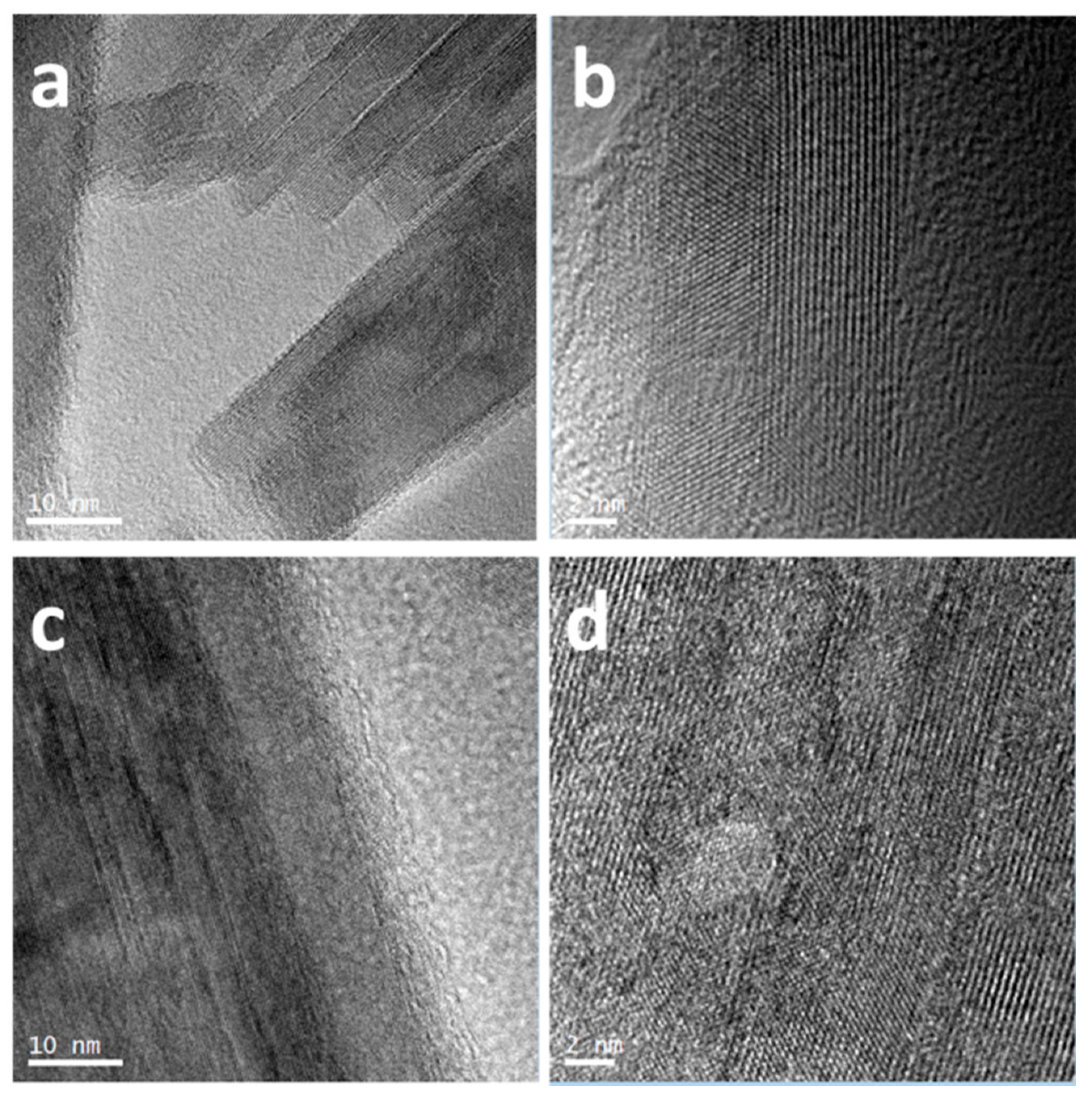
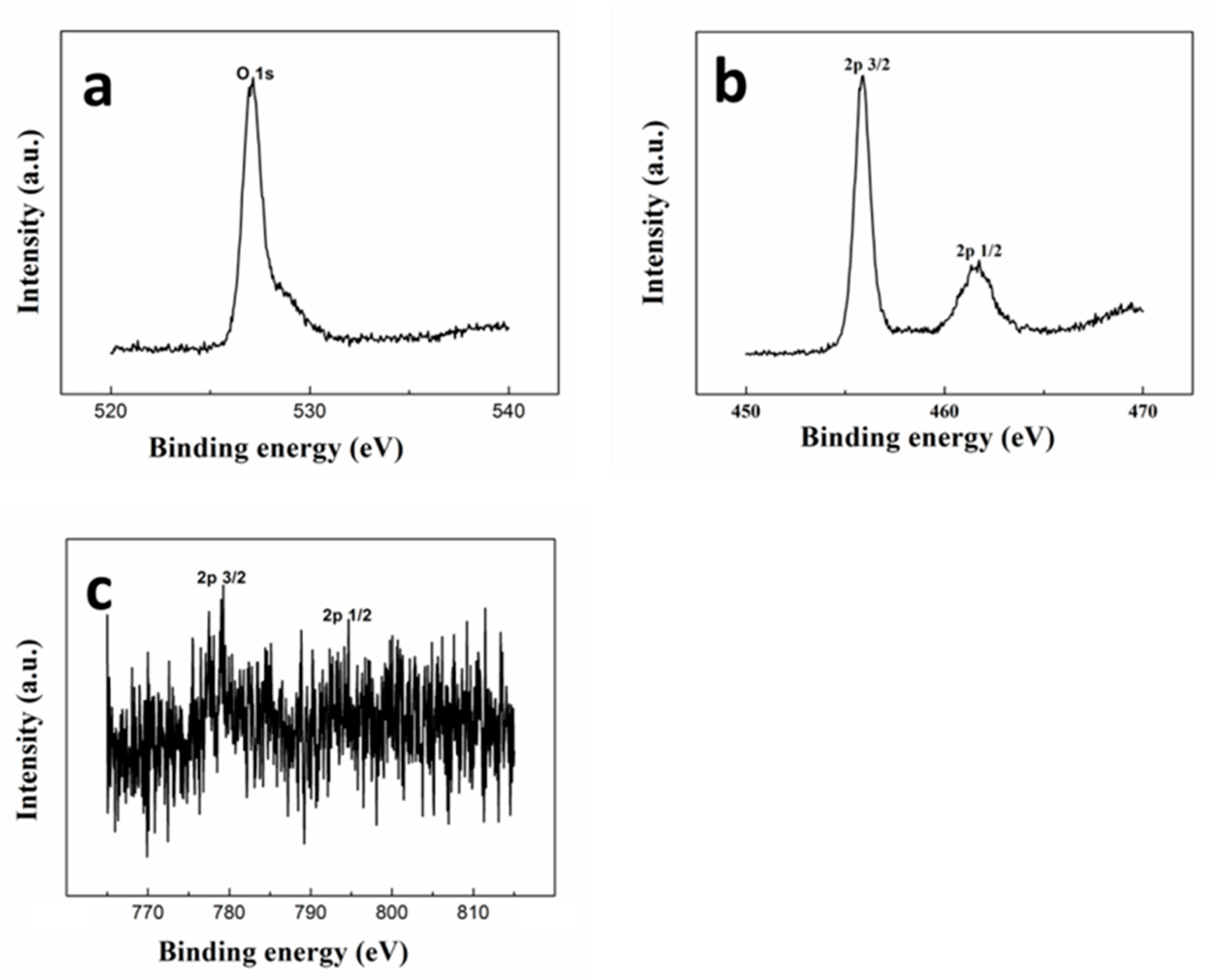

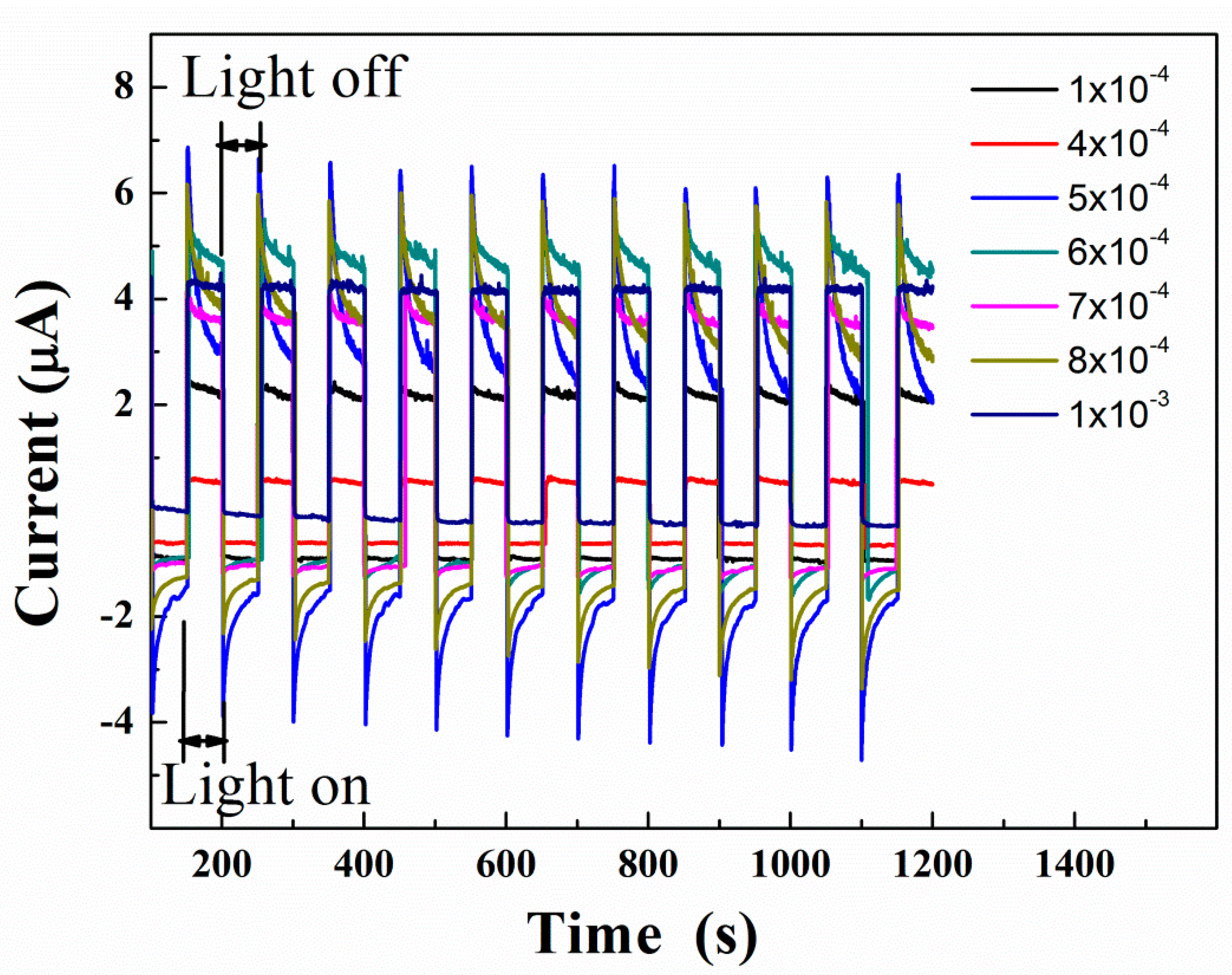
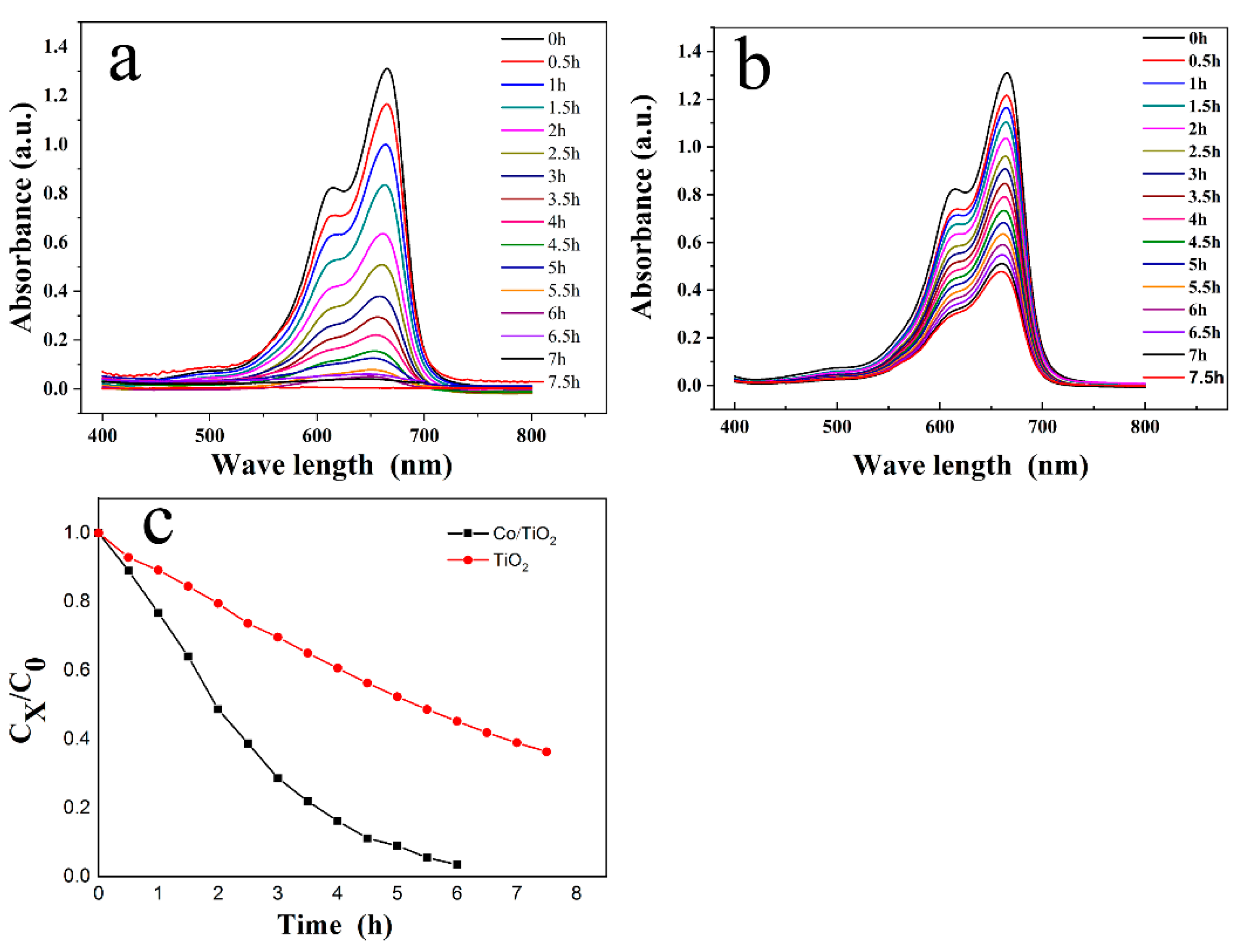

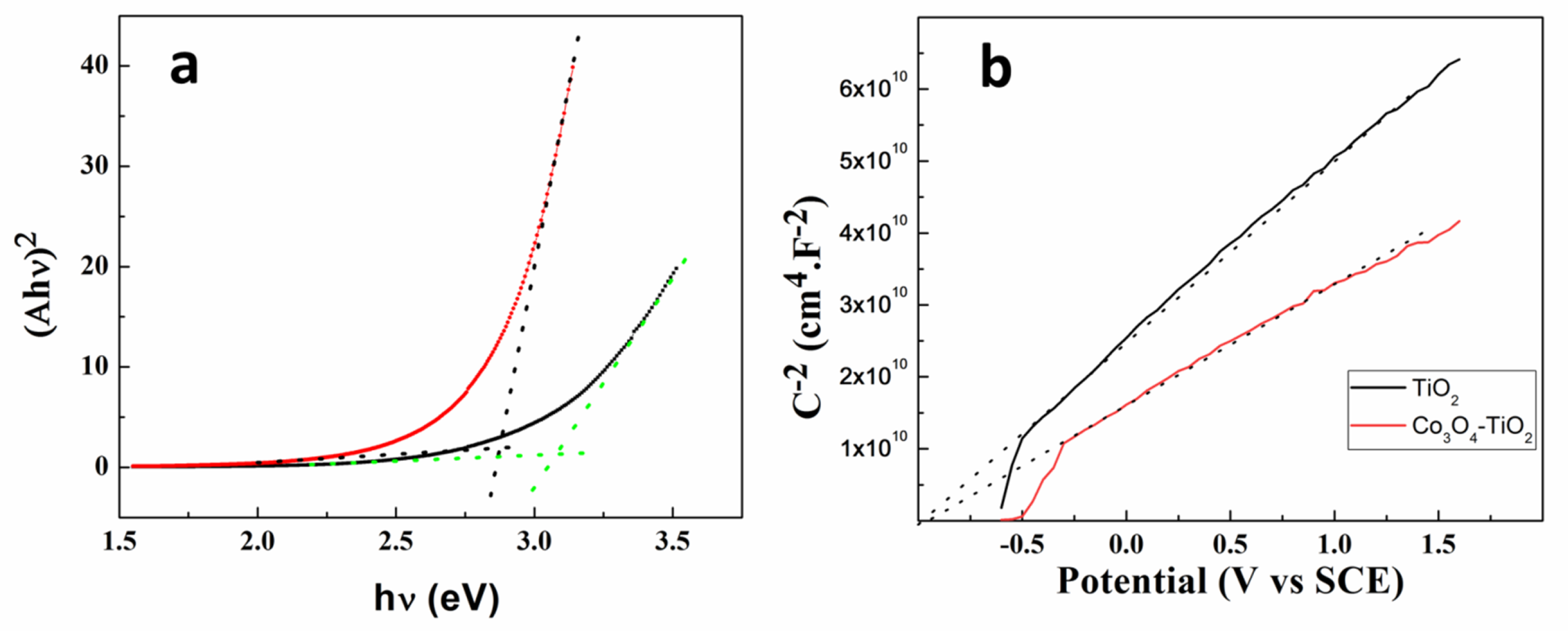
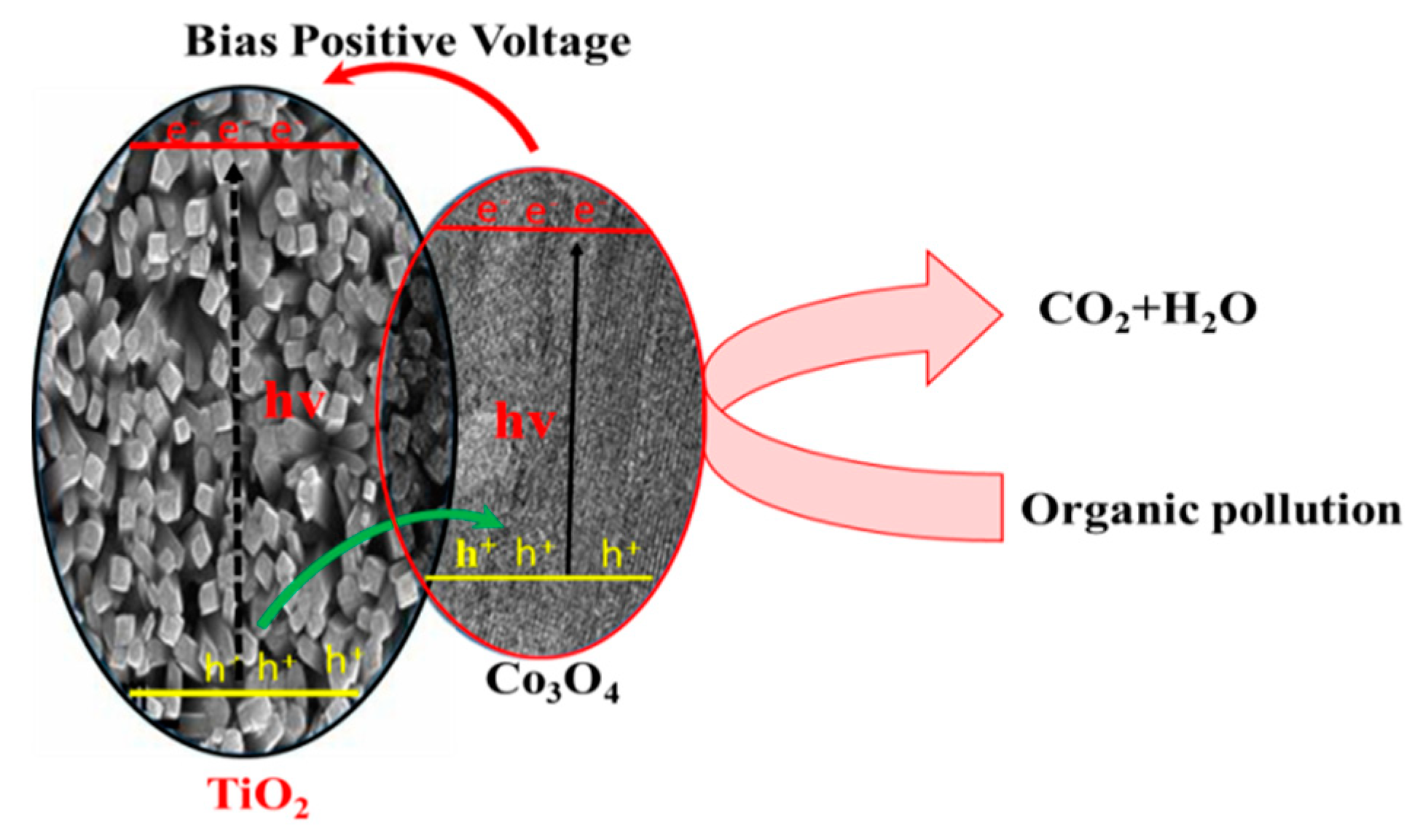
Publisher’s Note: MDPI stays neutral with regard to jurisdictional claims in published maps and institutional affiliations. |
© 2021 by the authors. Licensee MDPI, Basel, Switzerland. This article is an open access article distributed under the terms and conditions of the Creative Commons Attribution (CC BY) license (http://creativecommons.org/licenses/by/4.0/).
Share and Cite
Du, Y.; Zheng, Z.; Chang, W.; Liu, C.; Bai, Z.; Zhao, X.; Wang, C. Trace Amounts of Co3O4 Nano-Particles Modified TiO2 Nanorod Arrays for Boosted Photoelectrocatalytic Removal of Organic Pollutants in Water. Nanomaterials 2021, 11, 214. https://doi.org/10.3390/nano11010214
Du Y, Zheng Z, Chang W, Liu C, Bai Z, Zhao X, Wang C. Trace Amounts of Co3O4 Nano-Particles Modified TiO2 Nanorod Arrays for Boosted Photoelectrocatalytic Removal of Organic Pollutants in Water. Nanomaterials. 2021; 11(1):214. https://doi.org/10.3390/nano11010214
Chicago/Turabian StyleDu, Yongling, Zhixiang Zheng, Wenzhuo Chang, Chunyan Liu, Zhiyong Bai, Xinyin Zhao, and Chunming Wang. 2021. "Trace Amounts of Co3O4 Nano-Particles Modified TiO2 Nanorod Arrays for Boosted Photoelectrocatalytic Removal of Organic Pollutants in Water" Nanomaterials 11, no. 1: 214. https://doi.org/10.3390/nano11010214
APA StyleDu, Y., Zheng, Z., Chang, W., Liu, C., Bai, Z., Zhao, X., & Wang, C. (2021). Trace Amounts of Co3O4 Nano-Particles Modified TiO2 Nanorod Arrays for Boosted Photoelectrocatalytic Removal of Organic Pollutants in Water. Nanomaterials, 11(1), 214. https://doi.org/10.3390/nano11010214




